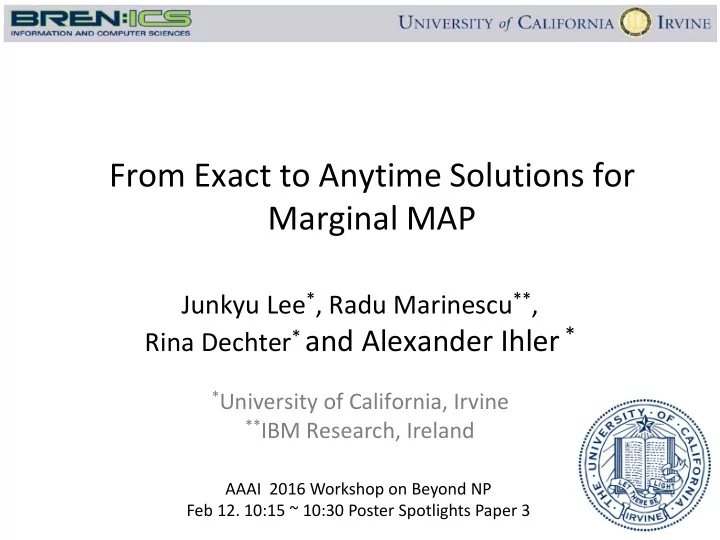

From Exact to Anytime Solutions for Marginal MAP Junkyu Lee * , Radu Marinescu ** , Rina Dechter * and Alexander Ihler * * University of California, Irvine ** IBM Research, Ireland AAAI 2016 Workshop on Beyond NP Feb 12. 10:15 ~ 10:30 Poster Spotlights Paper 3
Introduction Marginal MAP Mode of probability distribution after marginalizing subset of variables Complexity Class: NP PP Complete • MPE (NP-Complete) : optimizing over max variables • PR (#P-Complete) : evaluating full instantiation Application to Probabilistic Planning Marginal MAP query returns optimal probabilistic conformant plan* * “Applying Search Based Probabilistic Inference Algorithms to Probabilistic Conformant Planning: Preliminary Results”, 2016 ISAIM 1
Earlier Works on Marginal MAP Inference Earlier Approaches [Park & Darwiche 2003] [Yuan& Hansen 2009] • Exact Solution • Exact Solution • Depth First Branch and Bound • Depth First Branch and Bound with Dynamic Variable Ordering with Static Variable Ordering • Join-tree upper bound Relax ordering • Incremental Join-tree upper bound Systematic Search Algorithm Reduced heuristic computation time [Marinescue, Dechter, Ihler 2014] [Marinescue, Dechter, Ihler 2014] • Exact Solution • Exact Solution • AND/OR Branch and Bound • AND/OR Best First • WMB + Cost shifting schemes • AND/OR Recursive Best First Stronger Heuristic Best First Based Search Strategy Compacter AND/OR Search Space Avoid Solving Summation Problems [Liu, Iher 2013] Variational algorithms [Maua, De Campos 2012] Factor-set elimination algorithm Motivation Best First Schemes avoid evaluating summation sub problems, but they requires enormous amount of memory Turn to anytime approach 2
Probabilistic Graphical Models A graphical model ( X , D , F ) X = {X 1 , … , X n } variables D= {D 1 , … , D n } domains F= {f 1 , … , f m } functions Operators Combination (product) Elimination (max/sum) Tasks Probability of Evidence (PR) All these tasks are NP-hard Most Probable Explanation (MPE) Exploit problem structure (primal graph) Marginal MAP (Maximum A Posteriori) 3
AND/OR Search Space for MMAP constrained variable ordering constrained pseudo tree as backbone merge identical sub-problems (conditional independence) 4
Anytime AND/OR Search for MMAP Anytime AOBB (BRAOBB) Depth First Branch and Bound Breadth Rotate AOBB (AOBB) Prune node n if current best solution is Problem decomposition rejects anytime better than optimistic evaluation at n performance of AOBB Rotate through sub-problems 5
Anytime AND/OR Search for MMAP Weighted Best First Search AND/OR Best First Weighted Best First Initialize w While w >= 1 Inflate heuristic by w AOBF (sub-optimal solution within w) optionally Revise traversed search space reduce w Expand Nodes with best heuristic evaluation value f(n) Weighted Restarting AOBF (WAOBF) Weighted Restarting RBFAOO (WRBFAOO) Weighted Repairing AOBF (WRAOBF) 6
Experiment Setup Benchmark Instances Domain # instances GRID 75 Problem instances are modified PEDIGREE 50 from PASCAL2 Probabilistic Inference Challenge Data Set (http://www.cs.huji.ac.il/project/PASCAL/) PROMEDAS 50 Algorithm Parameters Algorithm Parameters Memory Weighted Mini Bucket Heuristic i-bound from 2 to 20 - BRAOBB Rotation Limit 1000 Max 24 GB WAOBF/ WRAOBF /WRBFAOO Starting Weight 64 Max 24 GB, Cache 4 GB Performance Measures Responsiveness, Quality Score 7
Performance Regimes Overall Pedigree Promedas AND/OR Search for MMAP Resp. Quality Resp. Quality Resp. Quality Exact AOBB 89% 339% 84% 342% 86% 405% AOBF 50% 208% 42% 158% 42% 258% RBFAOO 58% 90% 42% 95% 42% 132% WAOBF 82% 365% 88% 442% 54% 266% Anytime WRBFAOO 86% 394% 90% 440% 60% 305% WRAOBF 82% 339% 88% 364% 54% 261% BRAOBB 86% 365% 58% 259% 94% 473% • Summarized from 1 hour time bound, • Responsiveness: WMB-MM(18), Quality Score: WMB-MM(12) heuristic WRBFAOO is the overall best performed algorithm BRAOBB is the second best performer, but the best at PROMEDAS DOMAIN 8
WRBFAOO vs. BRAOBB Closer look at individual problem instances Easy Problems Harder Problems Wc < 60 200 < Wc 10 < Ws 60 < Wc < 200 Ws < 10 • Each point (Wc, Ws) represents difficulty of problem • Time/ Memory Complexity is Exponential in W 10
Conclusion Improvement from Exact to Anytime Anytime Best-First approach • Recovers responsiveness close to Depth-First schemes • Provide high quality solutions Future Work Better Search Strategy • Memory issue with hard problems (Ws > 10, Wc > 200) Integrate approximation for summation problems • From exact to approximation 11
Recommend
More recommend